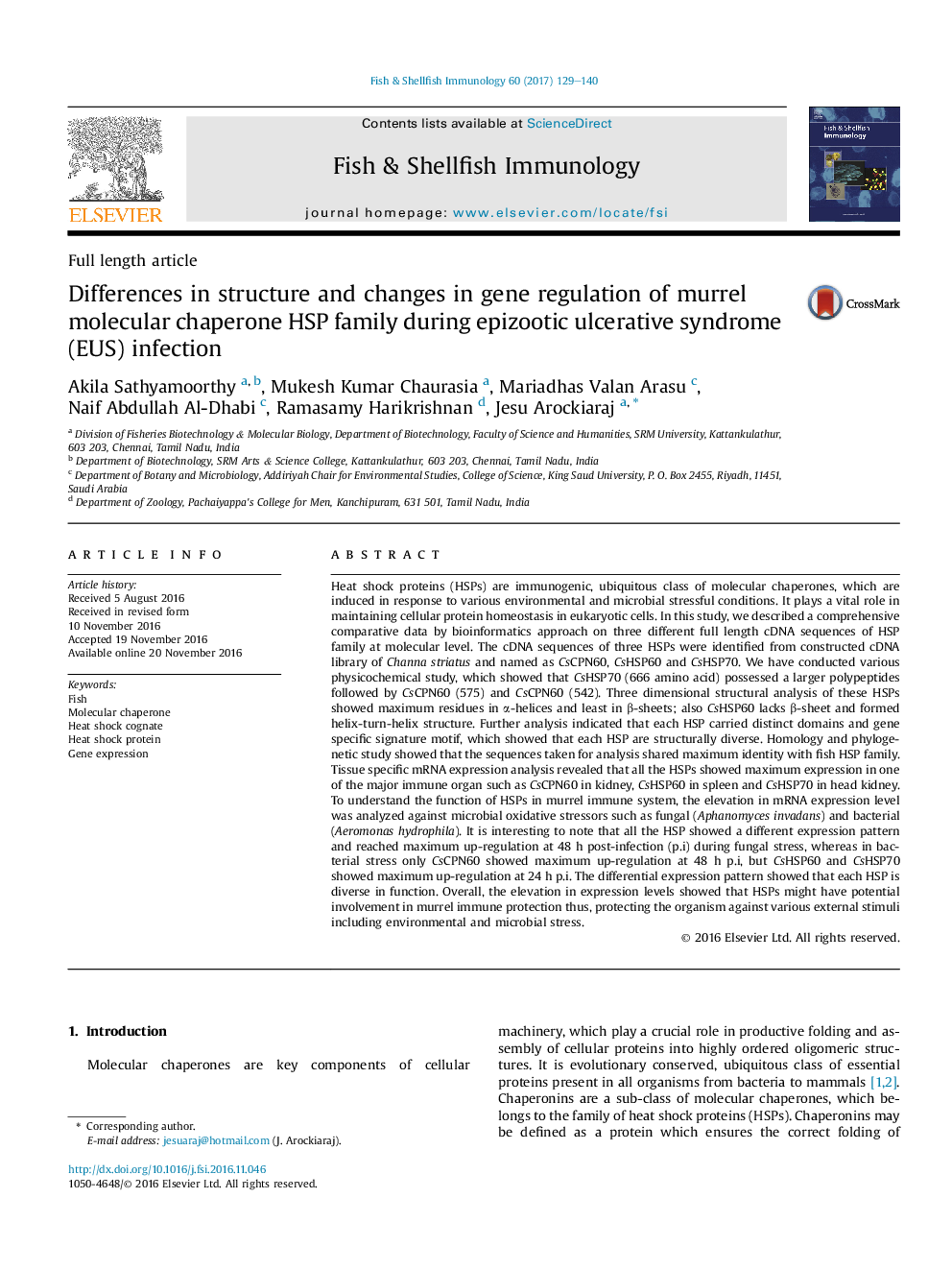| کد مقاله | کد نشریه | سال انتشار | مقاله انگلیسی | نسخه تمام متن |
|---|---|---|---|---|
| 5540971 | 1553614 | 2017 | 12 صفحه PDF | دانلود رایگان |
عنوان انگلیسی مقاله ISI
Differences in structure and changes in gene regulation of murrel molecular chaperone HSP family during epizootic ulcerative syndrome (EUS) infection
دانلود مقاله + سفارش ترجمه
دانلود مقاله ISI انگلیسی
رایگان برای ایرانیان
کلمات کلیدی
موضوعات مرتبط
علوم زیستی و بیوفناوری
علوم کشاورزی و بیولوژیک
علوم آبزیان
پیش نمایش صفحه اول مقاله

چکیده انگلیسی
Heat shock proteins (HSPs) are immunogenic, ubiquitous class of molecular chaperones, which are induced in response to various environmental and microbial stressful conditions. It plays a vital role in maintaining cellular protein homeostasis in eukaryotic cells. In this study, we described a comprehensive comparative data by bioinformatics approach on three different full length cDNA sequences of HSP family at molecular level. The cDNA sequences of three HSPs were identified from constructed cDNA library of Channa striatus and named as CsCPN60, CsHSP60 and CsHSP70. We have conducted various physicochemical study, which showed that CsHSP70 (666 amino acid) possessed a larger polypeptides followed by CsCPN60 (575) and CsCPN60 (542). Three dimensional structural analysis of these HSPs showed maximum residues in α-helices and least in β-sheets; also CsHSP60 lacks β-sheet and formed helix-turn-helix structure. Further analysis indicated that each HSP carried distinct domains and gene specific signature motif, which showed that each HSP are structurally diverse. Homology and phylogenetic study showed that the sequences taken for analysis shared maximum identity with fish HSP family. Tissue specific mRNA expression analysis revealed that all the HSPs showed maximum expression in one of the major immune organ such as CsCPN60 in kidney, CsHSP60 in spleen and CsHSP70 in head kidney. To understand the function of HSPs in murrel immune system, the elevation in mRNA expression level was analyzed against microbial oxidative stressors such as fungal (Aphanomyces invadans) and bacterial (Aeromonas hydrophila). It is interesting to note that all the HSP showed a different expression pattern and reached maximum up-regulation at 48 h post-infection (p.i) during fungal stress, whereas in bacterial stress only CsCPN60 showed maximum up-regulation at 48 h p.i, but CsHSP60 and CsHSP70 showed maximum up-regulation at 24 h p.i. The differential expression pattern showed that each HSP is diverse in function. Overall, the elevation in expression levels showed that HSPs might have potential involvement in murrel immune protection thus, protecting the organism against various external stimuli including environmental and microbial stress.
ناشر
Database: Elsevier - ScienceDirect (ساینس دایرکت)
Journal: Fish & Shellfish Immunology - Volume 60, January 2017, Pages 129-140
Journal: Fish & Shellfish Immunology - Volume 60, January 2017, Pages 129-140
نویسندگان
Akila Sathyamoorthy, Mukesh Kumar Chaurasia, Mariadhas Valan Arasu, Naif Abdullah Al-Dhabi, Ramasamy Harikrishnan, Jesu Arockiaraj,